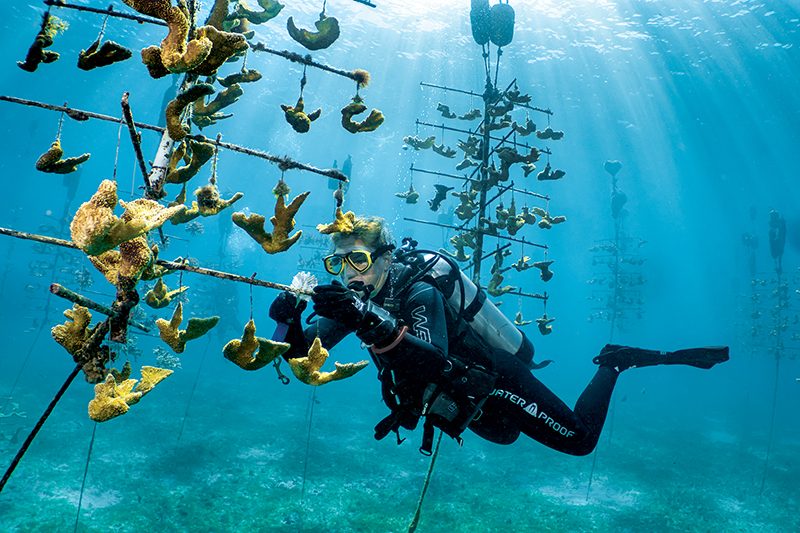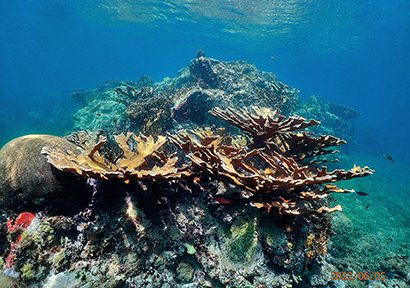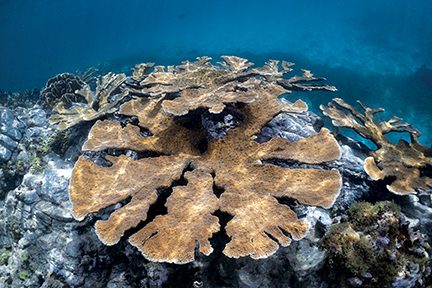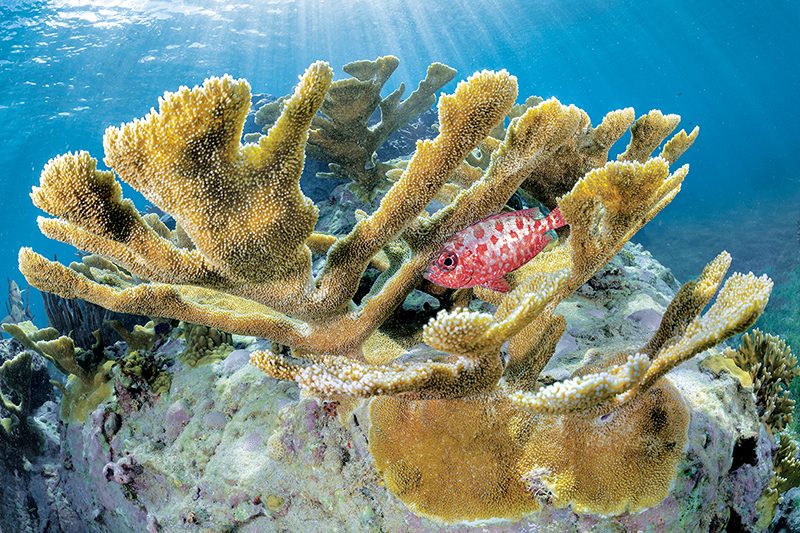IT’S NO SECRET THAT CARIBBEAN REEFS ARE IN CRISIS. Many stony coral species face an uncertain destiny, and some scientific predictors point toward extinction in the near future for some species.
Coral cover has declined dramatically since the 1960s, and the most significant losses are among the two dominant types of branching corals: elkhorn coral (Acropora palmata) and staghorn coral (Acropora cervicornis). These two critically important species have been reduced by 80 percent — up to 97 percent in some areas — of previous healthy baseline populations.


KEN MEDIMYER

DOUGLAS SEIFERT
The reasons for this stunning decline include watershed pollution (agricultural, chemical, and sewage outflows), overfishing, global sea temperature rise, coral diseases, and the mass mortality of long-spined sea urchins in 1983 and 1984. Long-spined sea urchins are a keystone herbivore species that help prevent fast-growing algaes from smothering coral colonies.
Mustique is a small, private island in the Caribbean’s Lesser Antilles and one of the 32 islands that make up St. Vincent and the Grenadines. Mustique is managed by The Mustique Company at the behest of the island’s approximately 100 foreign homeowners. In 2014 Bryan Adams, chairman of The Mustique Company’s Environmental Committee, was troubled by the degraded condition of the island’s corals. The reefs were scrubby rocks with some gorgonian soft corals and haggard-looking sea fans, extensive clumps of macroalgae, various species of sponges, and dispersed heads of brain and star corals. Fish were sparse and flighty.
Tidal surge and wave action continually massage the island, providing oxygenation and a steady supply of food — a secret sauce that makes the elkhorn corals thrive.
Mustique’s reefs were not always that way; 50 years ago they were beloved by snorkelers and divers. As the island developed, however, wastewater, fertilizer, and chemicals found their way into the sea, which may have lessened the corals’ resistance to disease. In 1986 Hurricane Danielle exacerbated this pollution, which caused wholesale devastation of the reefs in Plantation Bay off the island’s southwestern shore. The beautiful reefs of Mustique were but a fond memory.
In the years that followed, the Environmental Committee and the residents paid more attention to the human impacts to the island and put in place a variety of environmental measures, including eliminating freshwater and graywater runoff into the ocean through the construction of retaining walls, phasing out toxic chemicals, increasing recycling, phasing out plastic bags, minimizing single-use plastics, and increasing reliance on solar power. The island has a 1,000-yard no-take, no-fishing zone patrolled by island security.

DOUGLAS SEIFERT
Adams learned about the nascent coral restoration programs Ken Nedimyer, technical director for Reef Renewal USA, was implementing in the Florida Keys and wanted an assessment of Mustique’s reefs. Nedimyer and his team found them degraded but not entirely hopeless and proposed to rewild the reefs through coral plantings. Returning to the island in 2015, they set up a coral nursery seeded with fragments of locally harvested elkhorn, staghorn, and blade fire coral (Millipora complanata). They suspended these fragments in the water column of a shallow bay, hanging them from cross tees of fiberglass “trees,” buoyed by floatation and anchored to the bottom in 25 feet of water.
The fragments thrived and were soon harvested and broken down into 1 inch by 1 inch “frags” and attached to bare rock with marine epoxy. The coral began to grow and establish limestone skeletons, creating their own stable anchors to the rock substrate.
The tiny fragments of elkhorn and blade fire corals began to grow and thrive in the shallow water. Within a year it was clear that the corals were taking to this newly colonized stretch of rock reef. Elkhorn coral can grow 2 to 5 inches per year, and their colonies can live for decades, ultimately reaching 6 feet high and 12 feet wide under ideal conditions.
Tidal surge and wave action continually massage the island, providing oxygenation and a steady supply of food — a secret sauce that makes the elkhorn corals thrive. The staghorn corals, however, have not fared as well, growing for a time but then get smothered in mats of macroalgae that also thrive in the shallow, sunlit waters.
It has been seven years since the initial coral plantings, and the elkhorn corals have grown and expanded into impressive thickets. The coral branches shelter a variety of fish species, including squirrelfish, grunts, porcupinefish, trumpetfish, damselfish, angelfish, butterflyfish, and eels, as well as invertebrate dwellers such as sea urchins, lobsters, and octopuses. The reef has become busy, populated, and vibrant.
Since 2015 more than 7,500 coral fragments have been planted along Mustique’s coast. The biomass of fish is increasing, and the quality of sea life encounters is improving. But reef rewilding (restoration) does not equate to a return to nature in its original state. It involves making smart decisions, prioritizing the greater good, and achieving what is possible. Planting two or three types of coral in a locale that was once home to dozens of species may seem meager, but it is a start. Nedimyer likens it to planting a few species of trees in a reforestation project.
“You may only plant a couple species of trees, but as they grow, they attract wildlife, which facilitates the introduction of other species of plants and trees,” Nedimyer said. “Over time the replanted forest starts to look and function like a real forest.”
Recreating nature, or attempting to, is not without physical and financial costs, which the volunteers and community members bear. But what is the cost of not lending a hand to nature — especially when our predecessors caused the damage, inadvertently or not?
What is the value of a dead reef compared with the value of a living marine ecosystem?
Nature has a value beyond short-term financial windfalls, and we must pay without hesitation whatever price is required to make nature whole again.
While it’s still a work in progress, the restoration and rehabilitation of this formerly austere rock reef into a coral garden brings a great sense of achievement to the island community and its visitors and provides an example of a positive way forward for reef stewardship. AD
© Alert Diver — Q4 2022